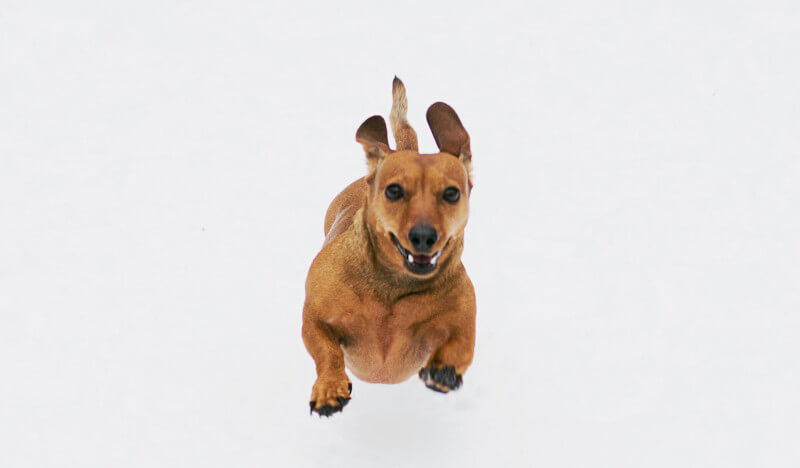Dachshunds can be extremely active pups, with a tendency to dig, bark above their weight, and occasionally be a little emotional, but you probably already knew that.
Their bravery renders them a commendable watchdog (but not an attack dog), and we must recognize their one-of-a-kind body shape and offer them a loving home that takes into account the physical limitations they have in order for them to flourish and lead lives that are both happy and injury-free.
The Dachshund’s long back and short legs present the single greatest challenge it faces in all aspects of life, especially when it comes to finding a comfy position on your bed or couch. It is not necessary to be Charles Darwin to recognize the physical constraints of their breeding, and as a result, it is our responsibility to know what is best for them, despite the fact that most of the time they are not aware of what is best for them.
They Simply Have Too Much Back
Living with such a long frame places a significant amount of strain on the individual’s back, which can result in a variety of orthopedic issues, the most serious of which is intervertebral disc disease, also known as IDD (IVDD).
IVDD is a problem with one or more of your dog’s intervertebral discs that are induced by repetitive, debilitating trauma. This trauma inevitably causes the material that is contained within the disc to permeate into the spinal column, which is what is meant by the term “IVDD.” Your dog may experience excruciating pain as a result of IVDD, and in some cases, it may even lead to complete paralysis.
Dogs that are afflicted with IVDD may display symptoms such as a limp or an unwillingness to be active. Among the more serious symptoms is a painful yelping response whenever the animal is picked up or touched. IVDD can be managed with anti-inflammatory medications in any circumstance; however, for more severe cases, surgical intervention may be required. It is entirely possible, and in most cases, just common sense, to reduce the likelihood that your dog will develop IVDD.
Please Don’t Let Them Take Part in Any Parkour
It is important to prevent Dachshunds from jumping off of any elevated platforms. Because “high” is a relative concept, we can say that for a Dachshund, a couch is considered “high.” Be aware that having a staircase in your home can be a significant obstacle for your Dachshund, as they were not designed to climb stairs. You could utilize a box or a portable step as an intermediate point for your Dachshund to climb down from the couch to the floor if you have one of these items.
Don’t Allow Them to Turn Into Literal Walking Worsies

Being overweight is the single most important factor in determining whether or not a Dachshund will have a future full of musculoskeletal conditions. The vertebrae, as well as the knees and hips, are subjected to additional strain when an unnecessary amount of weight is carried.
Seek advice from the veterinarian of your choice if you are uncertain as to whether or not your dog is overweight. The weight that was recorded for your dog when they were approximately ten months old is an appropriate weight to use as a baseline for their weight, even though you may not have that specific figure written down. You can also pet your dog by running your fingertips along the side of his body. There is a high likelihood that your dog is overweight if you are unable to feel its ribs when they are bent over.
There are breed-specific conditions that can be partially (or entirely) explained by genetics, and Dachshunds may have an increased risk of developing these hereditary conditions. DogSure, the pet insurance company of choice in South Africa for breeds like Dachshunds, provides unlimited advantages for all breeds of dogs. The company does not discriminate against any breeds and does not disallow hereditary conditions from the policy’s benefits.
Provide the Little Fursnakes With Consistent Opportunities for a Workout
Even though your friend is on the shorter side, that doesn’t mean that chasing each other around the house all day counts as sufficient exercise. Walking your dog frequently and for sufficient distances will not only help them build strong muscles that will support their back, but it will also make them much slimmer and healthier in general.
Additional Conditions That You Did Not Agree to When You Got Your Dogslinky
Your Dachshund may struggle with a condition known as intervertebral disc disease (IVDD), but because Dachshunds have such a distinctive hereditary structure, they are also more likely to be affected by a number of other conditions. Some of these conditions include a luxating patella, which is primarily a knee cap that frequently keeps popping out of its groove, and hip dysplasia, which is caused by a disfigurement in the hip joint.
Conclusion
You can prevent your Dachshunds from jumping from high places by training them or by offering them a step or box that they can waddle down. Maintaining a healthy weight through appropriate nutrition and consistent exercise is the most straightforward and efficient thing you can do to ensure long-term health and happiness. This applies regardless of the specifics of the situation.

